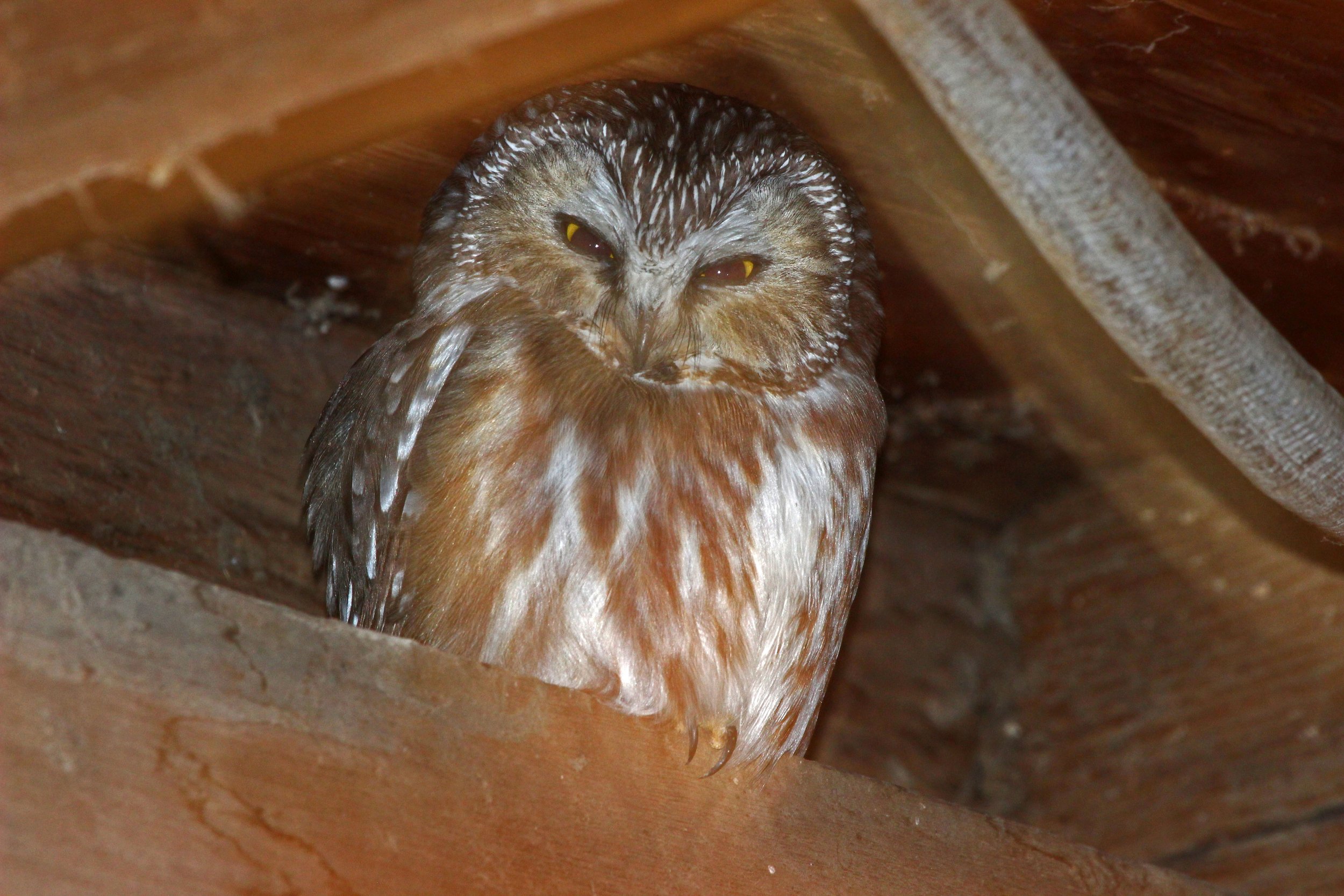March Nature Almanac: Early-Appearing Saw-whet Owls Face Deep-Freeze and Feral Cats
by Stephen Jones and Ruth Carol Cushman
March 2022
Birdwatchers flocked to Lafayette's Waneka Lake Park in late January and February for close-up views of one, and possibly two, Northern Saw-whet owls (Aegolius acadicus) roosting in deciduous trees near the shore. Louisville ornithologist Ted Floyd first posted the sighting to eBird on January 29.
In winter and early spring, Northern Saw-whet Owls often take cover in barns and other structures. Photo by Glenn Cushman.
Other saw-whets were reported at Meyers Gulch on January 30, in Broomfield on February 8 and 16, and at Wonderland Lake on February 19. Chris Petrizzo found a dead saw-whet lying on the grass at Stonegate Apartments in Broomfield on 16 February, a likely victim of a woodland hawk (either Accipiter cooperii or A. striatus). Feral house cats also take their toll on suburban saw-whets.
Chris Petrizzo found this Northern Saw-whet Owl carcass on the lawn in front of Broomfield's Stonegate Apartments on February 16. The little owl may have fallen victim to a woodland hawk (Accipiter sp.). Photo by Chris Petrizzo.
In fact, on February 20 Ted, his daughter Hannah, and his son Andrew rescued one of the Waneka saw-whets from the grasp of an oversized orange house cat. As they chased the cat away, the owl flew a short distance before splashing down in a snowdrift. After finally extricating itself, it flew to a nearby oak where it rested for a while until two more feral cats approached, forcing it to flee to a more sheltering juniper.
Then on the evening of February 22, an arctic cold front dropped into our area, dropping nighttime temperatures below zero for several days. Many of us wondered if the early-appearing saw-whets might perish. But Ted Floyd saw a saw-whet at Weneka on February 27, and another was seen in Massey Draw, at Ken Caryl Ranch, on 26 February, just as temperatures had begun to warm back up.
Standing just 5.5 inches tall and weighing less than 4 ounces, Northern Saw-whet Owls need to consume close to 20% of their body weight each winter day to keep body temperatures from plunging. However, there are few reports of adults owls dying from exposure or starvation.
Vehicle collisions do kill significant numbers of saw-whets each year, as hunting owls are drawn to mice and other rodents crossing roadways at night. A 10-year study along an 80-mile stretch of road in New Jersey determined that almost half of 250 road-killed raptors were saw-whet owls.
Most saw-whets nesting at latitudes above 40° N (that latitude where Boulder is located) appear to migrate south or downslope during the coldest months. However, their migratory patterns are complicated and poorly understood.
In Colorado, some saw-whets may remain in the mountains all winter, while others migrate from the high mountains down to the foothills or south as far as Mexico. Since they feed primarily on mice, voles, and shrews, which remain active in cold weather, catching prey in snowy landscapes may not pose a problem.
Most migratory activity appears to occur between midnight and dawn, with these lightweight, habitually nocturnal owls avoiding nights with high winds and full moons. Migrants typically move in short hops of 50 miles or less. However, saw-whets have been reported flying considerable distances over water, with one individual landing on a ship 70 miles off the New York coast and another found on the Farallon Islands, 20 miles off the California coast.
Observations of Northern Saw-whet Owls in Colorado during March from the eBird database.
Though saw-whets typically nest and hunt in open forests and woodlands, where tree cavities and prey abound, resting owls gravitate toward dense conifers where their small size and sedentary nature renders them virtually invisible. We have walked up to within a dozen feet of a perching saw-whet without the individual showing any sign of alarm. Nineteenth-century naturalists sometimes plucked individuals off their roosts by hand. To minimize disturbance of saw-whets (and any other raptor) in suburban and urban areas, please do not approach closely to view or photograph the owl. This is especially true of any known nests. Colorado Parks and Wildlife provides guidelines for approach and disturbance to a range of Colorado raptors.
When we first began studying small owls during the 1980s, we assumed that Colorado saw-whets nested only in the mountains. Observers have since found individuals breeding in east Boulder and Louisville. During the second Nebraska Breeding Bird Atlas, completed in 2016, observers found pairs nesting in wooded canyons throughout the western half of that state.
Recent studies suggest that these little owls may move around from one habitat to another in response to fluctuations in prey populations. While we have always considered them habitat generalists, we are beginning to understand how resourceful and adaptable they can be.
So if you find a little saw-whet perching in your backyard, she's probably not sick or lost. And if a cold front should drop-in, she'll most likely find a cozy hollow or barn to roost in and scurrying field mice and voles to feed on.
Other March Nature Events
Northern Pygmy-Owls begin calling in foothills and high mountain canyons. Their vocalizations sound syncopated ("toot-toot, toot, toot-toot-toot") in contrast to the more regular and insistent calls of Northern Saw-whet Owls. Listen to calls from the Macaulay Library: Northern Pygmy-Owl, Northern Saw-whet Owl.
During the first part of the month, listen for Sandhill Cranes and Snow Geese passing overhead on their way north.
Flocks of Mountain and Western Bluebirds gather on the plains before moving up into the foothills to nest.
Early Easter daisies, later than usual this year due to our autumn drought, begin blooming on shales adjacent to the Foothills Highway north of Boulder.
Pasqueflowers should begin blooming on Marshall Mesa and other sunny foothills locations by the end of the month.



